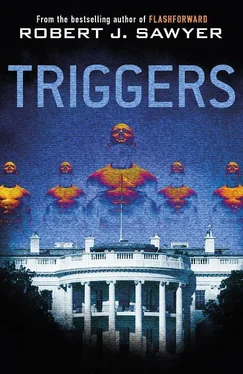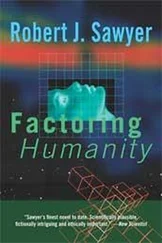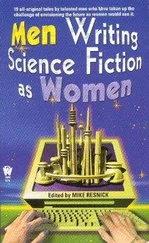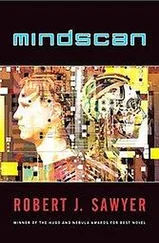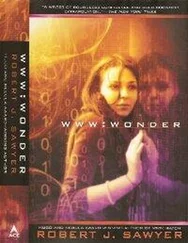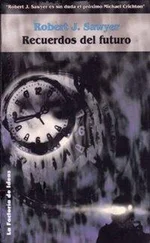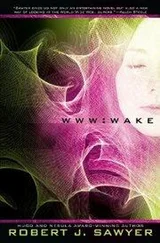“All right. Still, let’s test it. I’m going to go as far from you as I can without leaving the building, and we’ll see if the signal, um…attenuates? Is that the right word?”
“Yes.”
Susan left the lab and headed down the long corridor, passing patients on gurneys, doctors, nurses, and other people—several of whom tried to question her about how much longer the lockdown was going to last. She made it to the far end of the building as quickly as she could—and then, for good measure, she entered the stairwell and headed up to the sixth floor, which was the highest level.
She found a janitor there in a blue uniform, pushing a mop. “You!” Susan said, pointing at him. “Name a topic.”
“Excuse me?”
“A topic—something, anything—to think about.”
“Ma’am?”
“Oh, come on, man! It’s not that hard a question. Any topic.”
“Umm, like, um, baseball, do you mean?”
“Baseball! Fine. Thank you!” And then she turned her back on the no-doubt-bewildered man, closed her eyes, and concentrated on the first time she’d ever seen a baseball game live, and…
And a memory of her father taking her to Dodger Stadium came to her. She’d spilled her Pepsi all over him, and he’d laughed it off and squirted water at her. She shook her head, clearing her own memory, and tried to summon another, and—
And she was watching the Toronto Blue Jays play, and from a private box, something she herself had never done.
More details: others in the booth. Sikhs, remembered not because they were Sikhs but because the colors of their individual turbans had been noted; Sue had previously had no idea that such choices were individual fashion statements. A party, a celebration of…of…
Ah, yes. Of Ranjip’s brother’s eighteenth birthday, which—yes—had actually been the day before, but there’d been no game that day. A wonderful memory, a happy memory—and no sense at all that it was more difficult to access or recall than Singh’s memories had been when they’d been much closer together. She didn’t have to strain, didn’t have to cock an ear as if listening to something faint, didn’t have to do anything differently. It just came to her when she thought about it, as easily as when she’d been right next to Singh.
She headed along the sixth-floor corridor until she got to the stairwell near the elevator station, then went down to three.
Professor Singh was still in his lab. “The first baseball game you saw live was in Toronto, wasn’t it?” asked Susan. “For your brother’s eighteenth birthday? Your dad rented a private box at the SkyDome.”
Singh nodded. “Although they don’t call it that anymore. It’s the Rogers Centre now.”
“You remember it as the SkyDome.”
“No doubt.” He blinked. “So you had no trouble reading my memories, even from far away?”
“None.”
“I don’t understand that. There should have been attenuation, unless…”
“Yes?”
He swiveled his chair, turning his back on his computer. “It’s…no. No, it can’t be that.”
“What?”
Singh thought for a moment, then, seemingly out of the blue, said, “Do you ever watch Saturday Night Live?”
“Not since I was a teenager.”
“Remember when Mike Myers used to be on? He’d play a Jewish woman named Linda Richman, who had a call-in talk show. When she got emotional, she’d put her hand on her chest, and say, ‘I’m all verklempt. Talk amongst yourselves. I’ll give you a topic.’ And then she’d say something like, ‘The Civil War was neither civil nor a war—discuss.’ ”
“No, I don’t remember that. Oh, wait—um, yes, now I do.”
Singh smiled. “Exactly.”
“I think the one when the character said, ‘The peanut is neither a pea nor a nut’ was funnier.”
Singh nodded slightly. “Perhaps. But the point is, if I tell you to remember something that you don’t actually have memories of, but I do, you remember it, too. So, let me give you a topic—but don’t discuss it. Think about it; recall it. Okay?”
She nodded. “Okay.”
“Quantum entanglement,” he said.
Her first impulse was to pull a Linda Richman and say, “…is neither quantum nor entangled,” but she didn’t even know if that made sense, and—
And it didn’t make sense. Quantum entanglement was a property of quantum mechanics, and it did involve entangling things, and—
And it was weird. She’d never heard of anything like it. When pairs of particles are created simultaneously under the right circumstances, they can become linked in such a way that they continue to be connected no matter how far apart they become.
“Wow,” said Susan.
“Wow indeed,” said Ranjip. “Okay. Another topic—well, not really; it’s the same topic, but a different way of looking at it. Ready?”
Susan nodded.
“Spooky action at a distance,” Ranjip said.
Susan was startled that she knew this was something Einstein had said. And, yes, it was spooky. Change the spin of one entangled particle, and the spin of the other changes instantaneously; they are bound together in an almost magical way—again, no matter how far apart they get from each other.
“Got it,” said Susan, and then she surprised herself by asking a question. “But if it’s quantum entanglement, why aren’t the linkages symmetrical? I mean, if A can read B, why can’t B read A?”
“The linkages probably are symmetrical,” Singh replied. “That is, either A or B could change any specific shared memory for both of them—the shared memories are entangled, and changes to them at one location would change them at both. But symmetry doesn’t imply reciprocity. A and B have symmetrically shared memories that happen to have originally belonged to A. Meanwhile, B and C have symmetrically shared memories that happened to originally belong to B. And so on.”
“Ah,” said Susan. “I guess.”
“Okay,” said Singh. “New topic, sort of: Penrose and Hameroff.”
And that came to her, too: physicist Roger Penrose—a sometimes-collaborator with Stephen Hawking—and the anesthesiologist Stuart Hameroff had proposed that human consciousness was quantum mechanical in nature.
It was astonishing: to know something so complex and yet never have even heard of it before. It wasn’t like university lectures were running through her head at high speed, and it wasn’t like playing Trivial Pursuit, where she had to dig deeply to find the answers; these were things that Singh knew well, and so she knew them well, too, and they came effortlessly to mind as soon as he said the trigger words.
“Got it,” she said again.
“Okay, new topic: the design of my apparatus.”
And she now knew all about that, too: a device that used tuned lasers—which emitted photons, which were a type of particle that could indeed be entangled—to selectively excite neurons. His design actually displaced the photons that were already there and substituted new ones.
Then…
“Cytoskeleton.”
And:
“Microtubule.”
And:
“Bose-Einstein condensate.”
She shook her head, as if somehow that would get the pieces to sift out of the swirling jumble they were in and fall into place. And, after a moment, they did. “And this is legit?” Susan said at last.
“Well, it’s a legitimate theory,” replied Singh. “Penrose and Hameroff say the actual seat of consciousness, which, of course, must somehow interact with memory, is not in the chemical synapses but rather in quantum effects in the microtubules of the cytoskeleton—the internal scaffolding—of brain cells. Their theory has its passionate advocates—and passionate detractors. But if we are dealing with quantum entanglement, that could explain why the linkages don’t weaken over distance.”
Читать дальше
